Analyzing Singapore's Economy: GDP, Labor Market, and Inflation Trends
VerifiedAdded on 2023/04/26
|10
|2415
|469
Report
AI Summary
This report provides an economic analysis of Singapore, focusing on its production output, labor market, and price levels between 2005 and 2014. It examines the trends in real GDP per capita and real GDP growth, noting the significant increase in GDP except for a dip in 2009. The analysis includes the unemployment rate, which remained relatively low, and discusses the types of unemployment affecting Singapore. The report also covers inflation rates, highlighting the peak in 2008 and the factors contributing to inflation, such as imported commodities and labor costs. The study concludes that Singapore has a highly developed free market economy, driven by trade, shipping, logistics, and a business-friendly environment, with a focus on maintaining economic stability through fiscal and monetary policies.
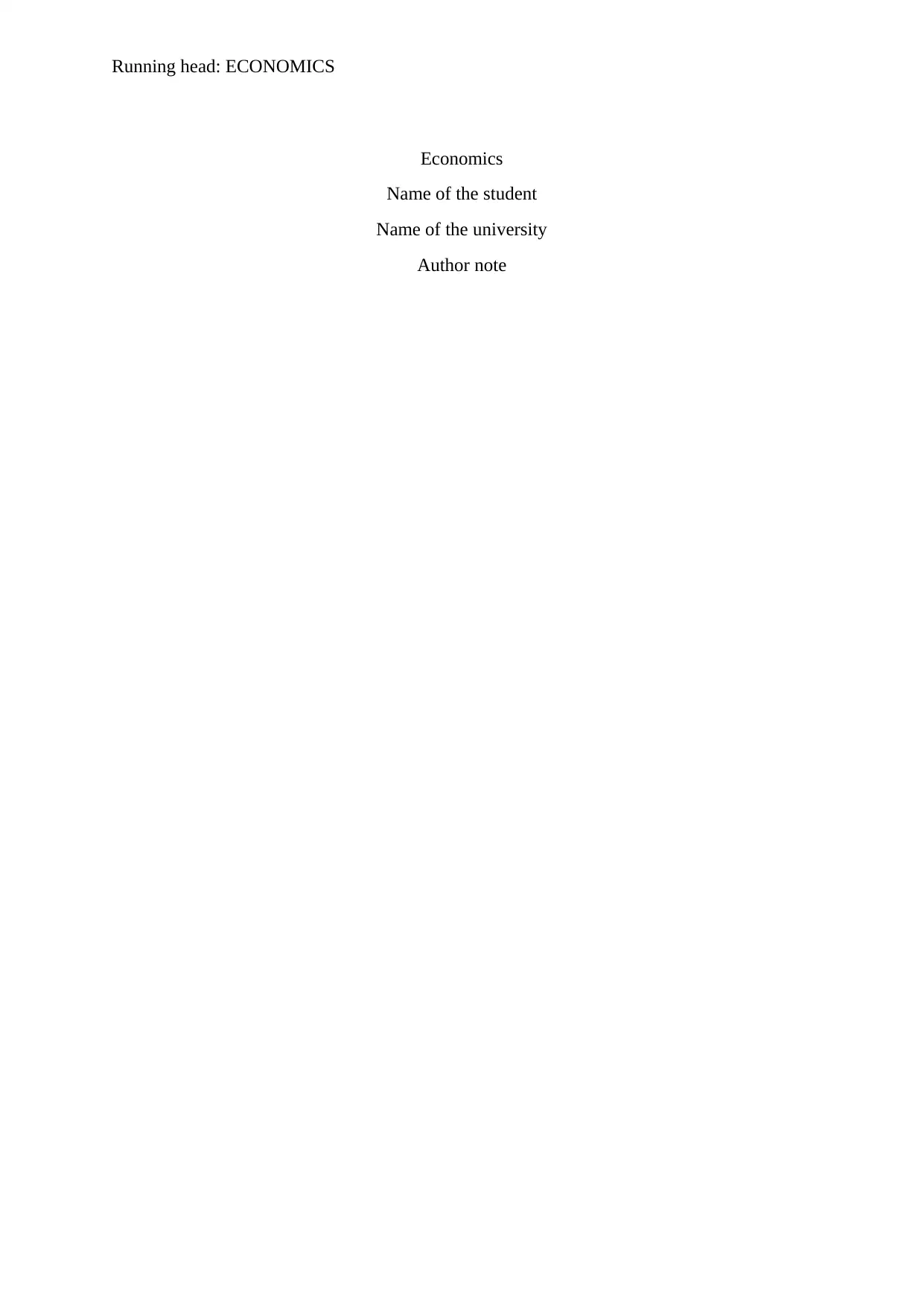
Running head: ECONOMICS
Economics
Name of the student
Name of the university
Author note
Economics
Name of the student
Name of the university
Author note
Paraphrase This Document
Need a fresh take? Get an instant paraphrase of this document with our AI Paraphraser
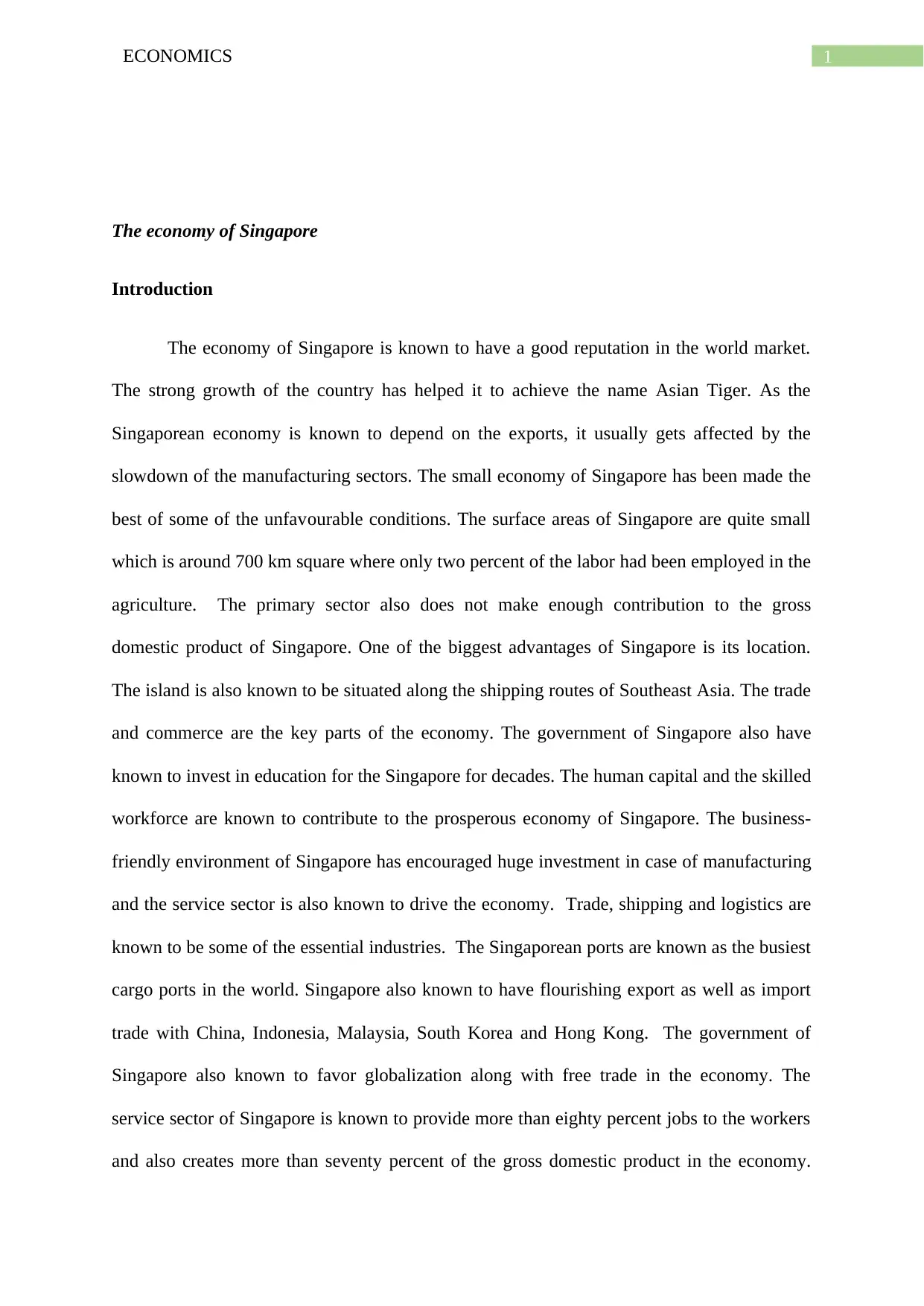
1ECONOMICS
The economy of Singapore
Introduction
The economy of Singapore is known to have a good reputation in the world market.
The strong growth of the country has helped it to achieve the name Asian Tiger. As the
Singaporean economy is known to depend on the exports, it usually gets affected by the
slowdown of the manufacturing sectors. The small economy of Singapore has been made the
best of some of the unfavourable conditions. The surface areas of Singapore are quite small
which is around 700 km square where only two percent of the labor had been employed in the
agriculture. The primary sector also does not make enough contribution to the gross
domestic product of Singapore. One of the biggest advantages of Singapore is its location.
The island is also known to be situated along the shipping routes of Southeast Asia. The trade
and commerce are the key parts of the economy. The government of Singapore also have
known to invest in education for the Singapore for decades. The human capital and the skilled
workforce are known to contribute to the prosperous economy of Singapore. The business-
friendly environment of Singapore has encouraged huge investment in case of manufacturing
and the service sector is also known to drive the economy. Trade, shipping and logistics are
known to be some of the essential industries. The Singaporean ports are known as the busiest
cargo ports in the world. Singapore also known to have flourishing export as well as import
trade with China, Indonesia, Malaysia, South Korea and Hong Kong. The government of
Singapore also known to favor globalization along with free trade in the economy. The
service sector of Singapore is known to provide more than eighty percent jobs to the workers
and also creates more than seventy percent of the gross domestic product in the economy.
The economy of Singapore
Introduction
The economy of Singapore is known to have a good reputation in the world market.
The strong growth of the country has helped it to achieve the name Asian Tiger. As the
Singaporean economy is known to depend on the exports, it usually gets affected by the
slowdown of the manufacturing sectors. The small economy of Singapore has been made the
best of some of the unfavourable conditions. The surface areas of Singapore are quite small
which is around 700 km square where only two percent of the labor had been employed in the
agriculture. The primary sector also does not make enough contribution to the gross
domestic product of Singapore. One of the biggest advantages of Singapore is its location.
The island is also known to be situated along the shipping routes of Southeast Asia. The trade
and commerce are the key parts of the economy. The government of Singapore also have
known to invest in education for the Singapore for decades. The human capital and the skilled
workforce are known to contribute to the prosperous economy of Singapore. The business-
friendly environment of Singapore has encouraged huge investment in case of manufacturing
and the service sector is also known to drive the economy. Trade, shipping and logistics are
known to be some of the essential industries. The Singaporean ports are known as the busiest
cargo ports in the world. Singapore also known to have flourishing export as well as import
trade with China, Indonesia, Malaysia, South Korea and Hong Kong. The government of
Singapore also known to favor globalization along with free trade in the economy. The
service sector of Singapore is known to provide more than eighty percent jobs to the workers
and also creates more than seventy percent of the gross domestic product in the economy.
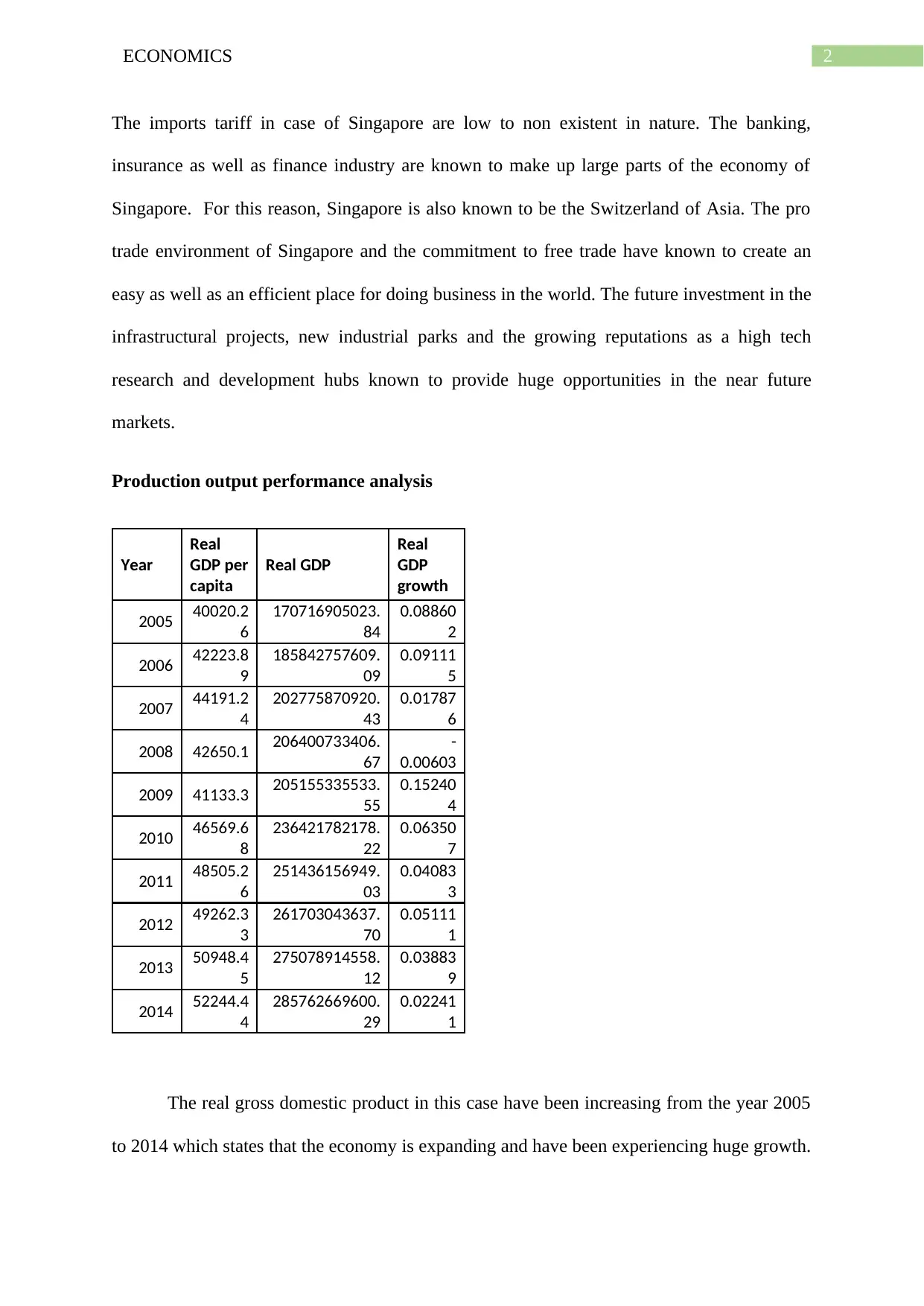
2ECONOMICS
The imports tariff in case of Singapore are low to non existent in nature. The banking,
insurance as well as finance industry are known to make up large parts of the economy of
Singapore. For this reason, Singapore is also known to be the Switzerland of Asia. The pro
trade environment of Singapore and the commitment to free trade have known to create an
easy as well as an efficient place for doing business in the world. The future investment in the
infrastructural projects, new industrial parks and the growing reputations as a high tech
research and development hubs known to provide huge opportunities in the near future
markets.
Production output performance analysis
Year
Real
GDP per
capita
Real GDP
Real
GDP
growth
2005 40020.2
6
170716905023.
84
0.08860
2
2006 42223.8
9
185842757609.
09
0.09111
5
2007 44191.2
4
202775870920.
43
0.01787
6
2008 42650.1 206400733406.
67
-
0.00603
2009 41133.3 205155335533.
55
0.15240
4
2010 46569.6
8
236421782178.
22
0.06350
7
2011 48505.2
6
251436156949.
03
0.04083
3
2012 49262.3
3
261703043637.
70
0.05111
1
2013 50948.4
5
275078914558.
12
0.03883
9
2014 52244.4
4
285762669600.
29
0.02241
1
The real gross domestic product in this case have been increasing from the year 2005
to 2014 which states that the economy is expanding and have been experiencing huge growth.
The imports tariff in case of Singapore are low to non existent in nature. The banking,
insurance as well as finance industry are known to make up large parts of the economy of
Singapore. For this reason, Singapore is also known to be the Switzerland of Asia. The pro
trade environment of Singapore and the commitment to free trade have known to create an
easy as well as an efficient place for doing business in the world. The future investment in the
infrastructural projects, new industrial parks and the growing reputations as a high tech
research and development hubs known to provide huge opportunities in the near future
markets.
Production output performance analysis
Year
Real
GDP per
capita
Real GDP
Real
GDP
growth
2005 40020.2
6
170716905023.
84
0.08860
2
2006 42223.8
9
185842757609.
09
0.09111
5
2007 44191.2
4
202775870920.
43
0.01787
6
2008 42650.1 206400733406.
67
-
0.00603
2009 41133.3 205155335533.
55
0.15240
4
2010 46569.6
8
236421782178.
22
0.06350
7
2011 48505.2
6
251436156949.
03
0.04083
3
2012 49262.3
3
261703043637.
70
0.05111
1
2013 50948.4
5
275078914558.
12
0.03883
9
2014 52244.4
4
285762669600.
29
0.02241
1
The real gross domestic product in this case have been increasing from the year 2005
to 2014 which states that the economy is expanding and have been experiencing huge growth.
⊘ This is a preview!⊘
Do you want full access?
Subscribe today to unlock all pages.

Trusted by 1+ million students worldwide
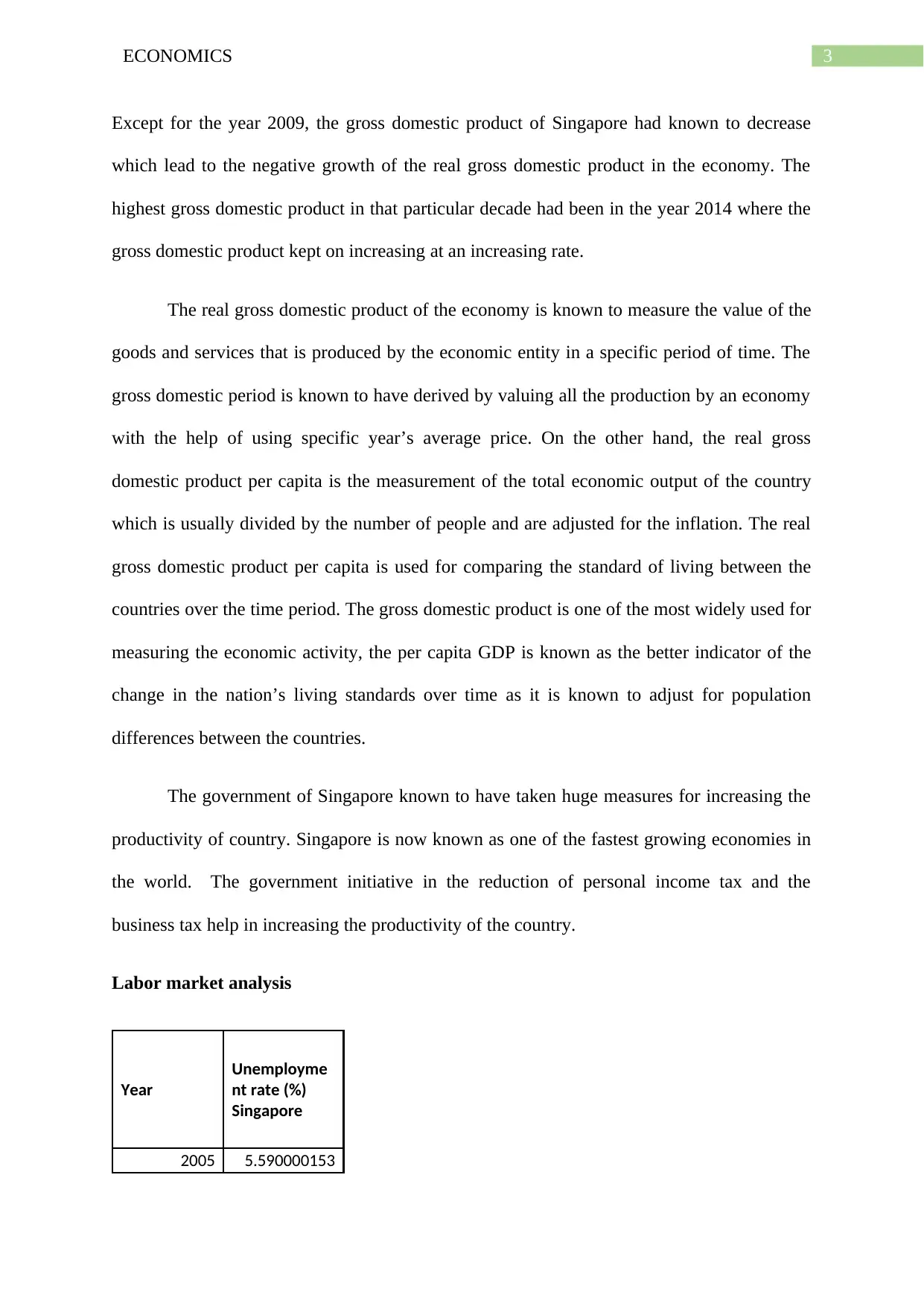
3ECONOMICS
Except for the year 2009, the gross domestic product of Singapore had known to decrease
which lead to the negative growth of the real gross domestic product in the economy. The
highest gross domestic product in that particular decade had been in the year 2014 where the
gross domestic product kept on increasing at an increasing rate.
The real gross domestic product of the economy is known to measure the value of the
goods and services that is produced by the economic entity in a specific period of time. The
gross domestic period is known to have derived by valuing all the production by an economy
with the help of using specific year’s average price. On the other hand, the real gross
domestic product per capita is the measurement of the total economic output of the country
which is usually divided by the number of people and are adjusted for the inflation. The real
gross domestic product per capita is used for comparing the standard of living between the
countries over the time period. The gross domestic product is one of the most widely used for
measuring the economic activity, the per capita GDP is known as the better indicator of the
change in the nation’s living standards over time as it is known to adjust for population
differences between the countries.
The government of Singapore known to have taken huge measures for increasing the
productivity of country. Singapore is now known as one of the fastest growing economies in
the world. The government initiative in the reduction of personal income tax and the
business tax help in increasing the productivity of the country.
Labor market analysis
Year
Unemployme
nt rate (%)
Singapore
2005 5.590000153
Except for the year 2009, the gross domestic product of Singapore had known to decrease
which lead to the negative growth of the real gross domestic product in the economy. The
highest gross domestic product in that particular decade had been in the year 2014 where the
gross domestic product kept on increasing at an increasing rate.
The real gross domestic product of the economy is known to measure the value of the
goods and services that is produced by the economic entity in a specific period of time. The
gross domestic period is known to have derived by valuing all the production by an economy
with the help of using specific year’s average price. On the other hand, the real gross
domestic product per capita is the measurement of the total economic output of the country
which is usually divided by the number of people and are adjusted for the inflation. The real
gross domestic product per capita is used for comparing the standard of living between the
countries over the time period. The gross domestic product is one of the most widely used for
measuring the economic activity, the per capita GDP is known as the better indicator of the
change in the nation’s living standards over time as it is known to adjust for population
differences between the countries.
The government of Singapore known to have taken huge measures for increasing the
productivity of country. Singapore is now known as one of the fastest growing economies in
the world. The government initiative in the reduction of personal income tax and the
business tax help in increasing the productivity of the country.
Labor market analysis
Year
Unemployme
nt rate (%)
Singapore
2005 5.590000153
Paraphrase This Document
Need a fresh take? Get an instant paraphrase of this document with our AI Paraphraser
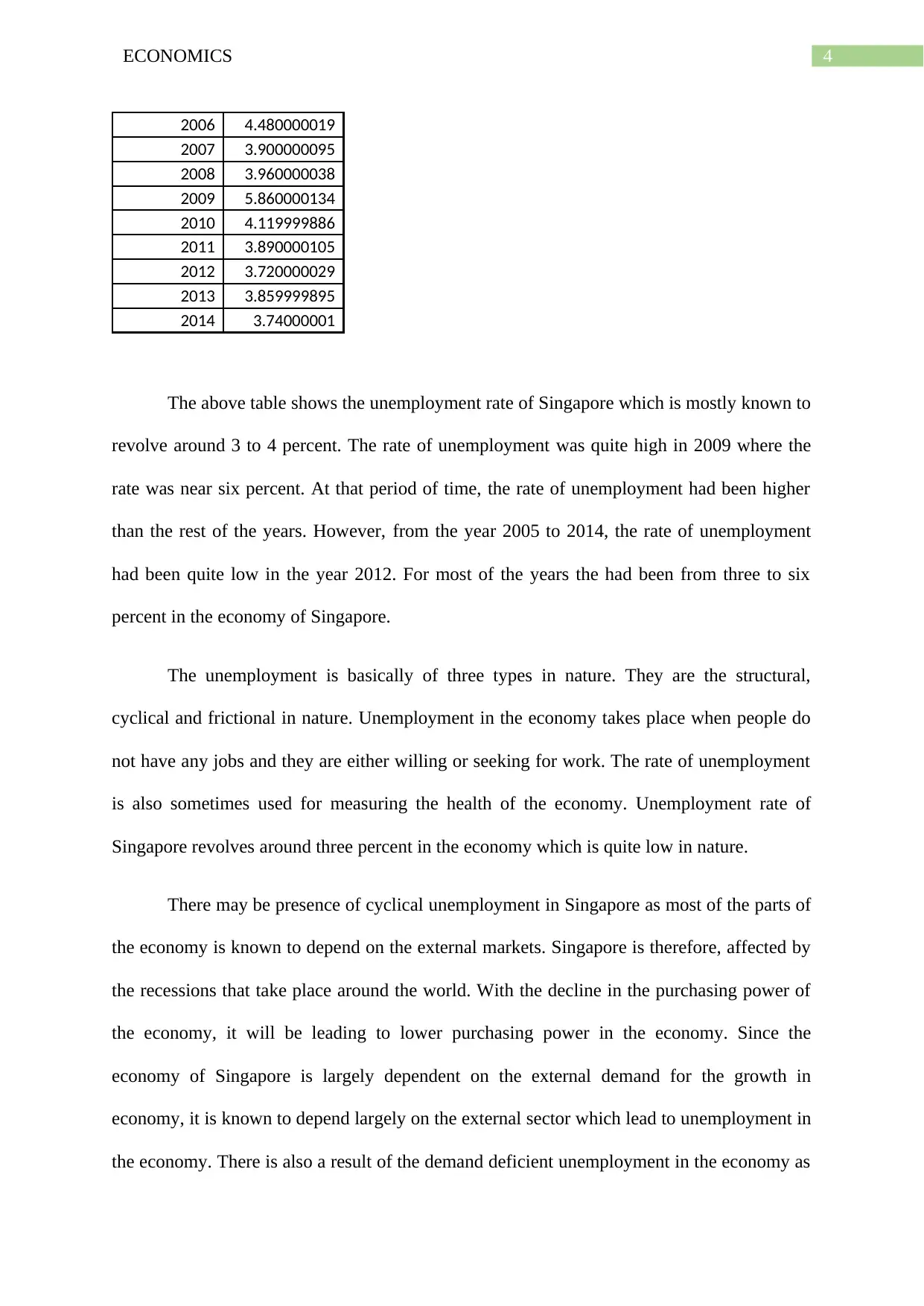
4ECONOMICS
2006 4.480000019
2007 3.900000095
2008 3.960000038
2009 5.860000134
2010 4.119999886
2011 3.890000105
2012 3.720000029
2013 3.859999895
2014 3.74000001
The above table shows the unemployment rate of Singapore which is mostly known to
revolve around 3 to 4 percent. The rate of unemployment was quite high in 2009 where the
rate was near six percent. At that period of time, the rate of unemployment had been higher
than the rest of the years. However, from the year 2005 to 2014, the rate of unemployment
had been quite low in the year 2012. For most of the years the had been from three to six
percent in the economy of Singapore.
The unemployment is basically of three types in nature. They are the structural,
cyclical and frictional in nature. Unemployment in the economy takes place when people do
not have any jobs and they are either willing or seeking for work. The rate of unemployment
is also sometimes used for measuring the health of the economy. Unemployment rate of
Singapore revolves around three percent in the economy which is quite low in nature.
There may be presence of cyclical unemployment in Singapore as most of the parts of
the economy is known to depend on the external markets. Singapore is therefore, affected by
the recessions that take place around the world. With the decline in the purchasing power of
the economy, it will be leading to lower purchasing power in the economy. Since the
economy of Singapore is largely dependent on the external demand for the growth in
economy, it is known to depend largely on the external sector which lead to unemployment in
the economy. There is also a result of the demand deficient unemployment in the economy as
2006 4.480000019
2007 3.900000095
2008 3.960000038
2009 5.860000134
2010 4.119999886
2011 3.890000105
2012 3.720000029
2013 3.859999895
2014 3.74000001
The above table shows the unemployment rate of Singapore which is mostly known to
revolve around 3 to 4 percent. The rate of unemployment was quite high in 2009 where the
rate was near six percent. At that period of time, the rate of unemployment had been higher
than the rest of the years. However, from the year 2005 to 2014, the rate of unemployment
had been quite low in the year 2012. For most of the years the had been from three to six
percent in the economy of Singapore.
The unemployment is basically of three types in nature. They are the structural,
cyclical and frictional in nature. Unemployment in the economy takes place when people do
not have any jobs and they are either willing or seeking for work. The rate of unemployment
is also sometimes used for measuring the health of the economy. Unemployment rate of
Singapore revolves around three percent in the economy which is quite low in nature.
There may be presence of cyclical unemployment in Singapore as most of the parts of
the economy is known to depend on the external markets. Singapore is therefore, affected by
the recessions that take place around the world. With the decline in the purchasing power of
the economy, it will be leading to lower purchasing power in the economy. Since the
economy of Singapore is largely dependent on the external demand for the growth in
economy, it is known to depend largely on the external sector which lead to unemployment in
the economy. There is also a result of the demand deficient unemployment in the economy as
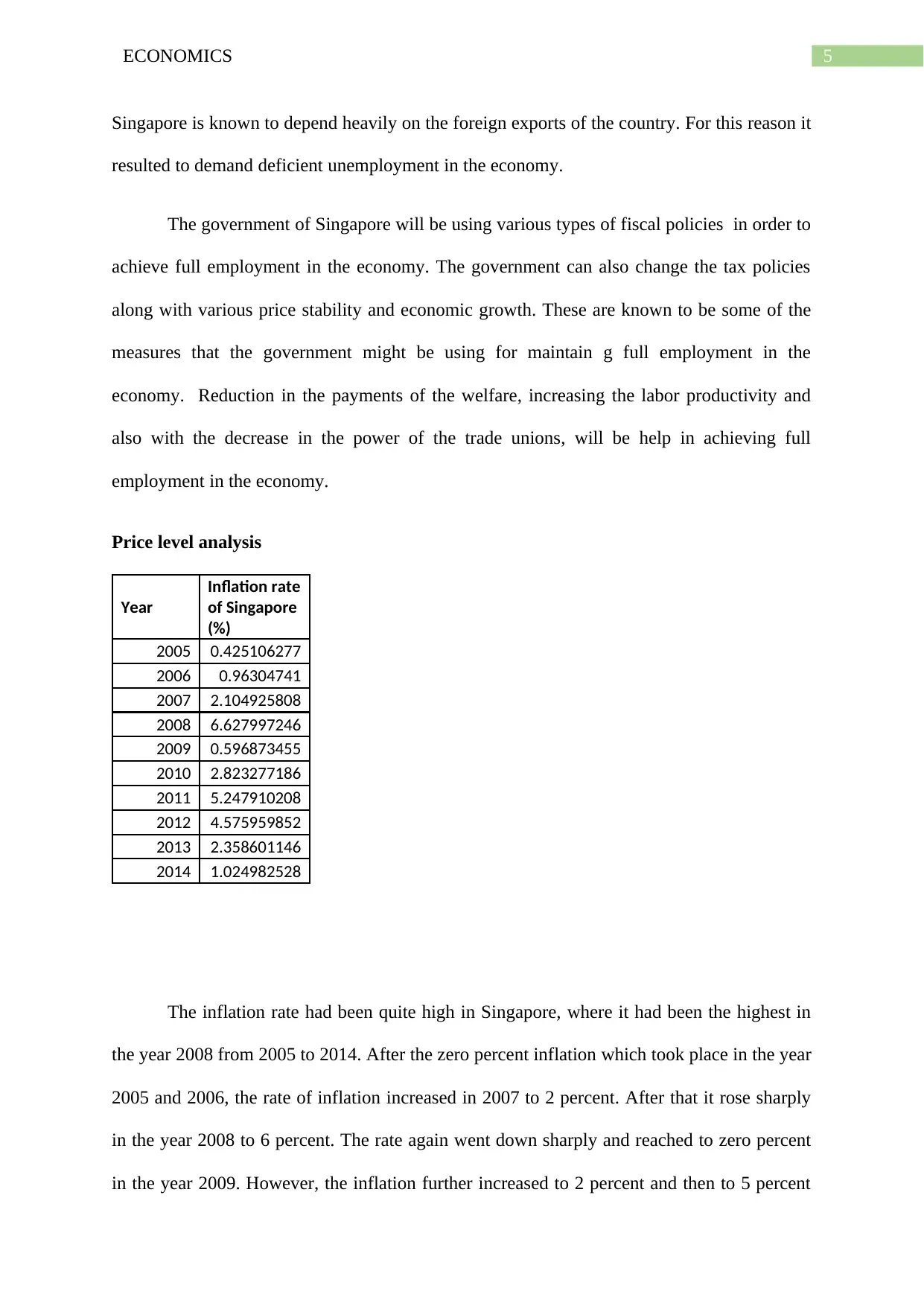
5ECONOMICS
Singapore is known to depend heavily on the foreign exports of the country. For this reason it
resulted to demand deficient unemployment in the economy.
The government of Singapore will be using various types of fiscal policies in order to
achieve full employment in the economy. The government can also change the tax policies
along with various price stability and economic growth. These are known to be some of the
measures that the government might be using for maintain g full employment in the
economy. Reduction in the payments of the welfare, increasing the labor productivity and
also with the decrease in the power of the trade unions, will be help in achieving full
employment in the economy.
Price level analysis
Year
Inflation rate
of Singapore
(%)
2005 0.425106277
2006 0.96304741
2007 2.104925808
2008 6.627997246
2009 0.596873455
2010 2.823277186
2011 5.247910208
2012 4.575959852
2013 2.358601146
2014 1.024982528
The inflation rate had been quite high in Singapore, where it had been the highest in
the year 2008 from 2005 to 2014. After the zero percent inflation which took place in the year
2005 and 2006, the rate of inflation increased in 2007 to 2 percent. After that it rose sharply
in the year 2008 to 6 percent. The rate again went down sharply and reached to zero percent
in the year 2009. However, the inflation further increased to 2 percent and then to 5 percent
Singapore is known to depend heavily on the foreign exports of the country. For this reason it
resulted to demand deficient unemployment in the economy.
The government of Singapore will be using various types of fiscal policies in order to
achieve full employment in the economy. The government can also change the tax policies
along with various price stability and economic growth. These are known to be some of the
measures that the government might be using for maintain g full employment in the
economy. Reduction in the payments of the welfare, increasing the labor productivity and
also with the decrease in the power of the trade unions, will be help in achieving full
employment in the economy.
Price level analysis
Year
Inflation rate
of Singapore
(%)
2005 0.425106277
2006 0.96304741
2007 2.104925808
2008 6.627997246
2009 0.596873455
2010 2.823277186
2011 5.247910208
2012 4.575959852
2013 2.358601146
2014 1.024982528
The inflation rate had been quite high in Singapore, where it had been the highest in
the year 2008 from 2005 to 2014. After the zero percent inflation which took place in the year
2005 and 2006, the rate of inflation increased in 2007 to 2 percent. After that it rose sharply
in the year 2008 to 6 percent. The rate again went down sharply and reached to zero percent
in the year 2009. However, the inflation further increased to 2 percent and then to 5 percent
⊘ This is a preview!⊘
Do you want full access?
Subscribe today to unlock all pages.

Trusted by 1+ million students worldwide
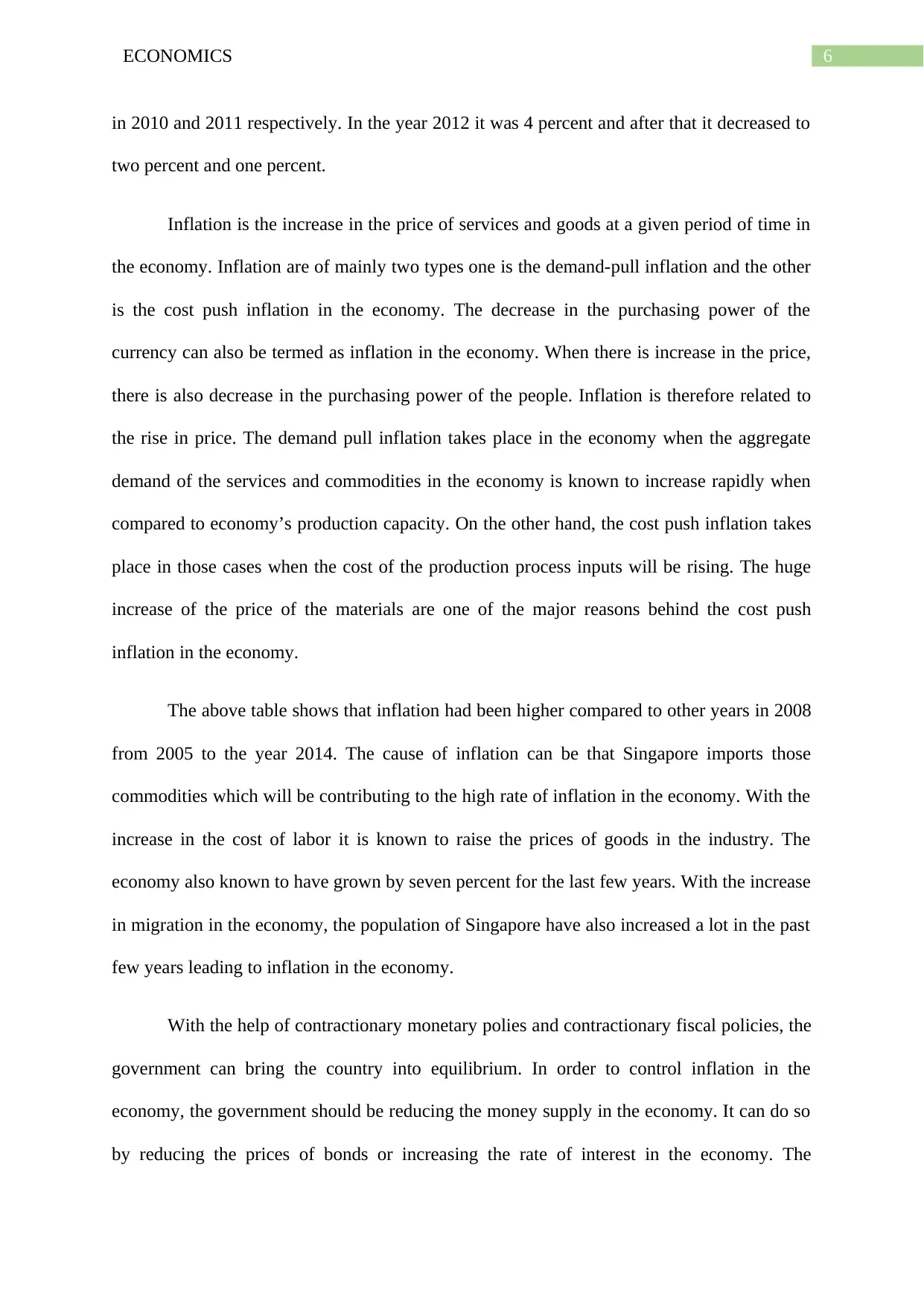
6ECONOMICS
in 2010 and 2011 respectively. In the year 2012 it was 4 percent and after that it decreased to
two percent and one percent.
Inflation is the increase in the price of services and goods at a given period of time in
the economy. Inflation are of mainly two types one is the demand-pull inflation and the other
is the cost push inflation in the economy. The decrease in the purchasing power of the
currency can also be termed as inflation in the economy. When there is increase in the price,
there is also decrease in the purchasing power of the people. Inflation is therefore related to
the rise in price. The demand pull inflation takes place in the economy when the aggregate
demand of the services and commodities in the economy is known to increase rapidly when
compared to economy’s production capacity. On the other hand, the cost push inflation takes
place in those cases when the cost of the production process inputs will be rising. The huge
increase of the price of the materials are one of the major reasons behind the cost push
inflation in the economy.
The above table shows that inflation had been higher compared to other years in 2008
from 2005 to the year 2014. The cause of inflation can be that Singapore imports those
commodities which will be contributing to the high rate of inflation in the economy. With the
increase in the cost of labor it is known to raise the prices of goods in the industry. The
economy also known to have grown by seven percent for the last few years. With the increase
in migration in the economy, the population of Singapore have also increased a lot in the past
few years leading to inflation in the economy.
With the help of contractionary monetary polies and contractionary fiscal policies, the
government can bring the country into equilibrium. In order to control inflation in the
economy, the government should be reducing the money supply in the economy. It can do so
by reducing the prices of bonds or increasing the rate of interest in the economy. The
in 2010 and 2011 respectively. In the year 2012 it was 4 percent and after that it decreased to
two percent and one percent.
Inflation is the increase in the price of services and goods at a given period of time in
the economy. Inflation are of mainly two types one is the demand-pull inflation and the other
is the cost push inflation in the economy. The decrease in the purchasing power of the
currency can also be termed as inflation in the economy. When there is increase in the price,
there is also decrease in the purchasing power of the people. Inflation is therefore related to
the rise in price. The demand pull inflation takes place in the economy when the aggregate
demand of the services and commodities in the economy is known to increase rapidly when
compared to economy’s production capacity. On the other hand, the cost push inflation takes
place in those cases when the cost of the production process inputs will be rising. The huge
increase of the price of the materials are one of the major reasons behind the cost push
inflation in the economy.
The above table shows that inflation had been higher compared to other years in 2008
from 2005 to the year 2014. The cause of inflation can be that Singapore imports those
commodities which will be contributing to the high rate of inflation in the economy. With the
increase in the cost of labor it is known to raise the prices of goods in the industry. The
economy also known to have grown by seven percent for the last few years. With the increase
in migration in the economy, the population of Singapore have also increased a lot in the past
few years leading to inflation in the economy.
With the help of contractionary monetary polies and contractionary fiscal policies, the
government can bring the country into equilibrium. In order to control inflation in the
economy, the government should be reducing the money supply in the economy. It can do so
by reducing the prices of bonds or increasing the rate of interest in the economy. The
Paraphrase This Document
Need a fresh take? Get an instant paraphrase of this document with our AI Paraphraser
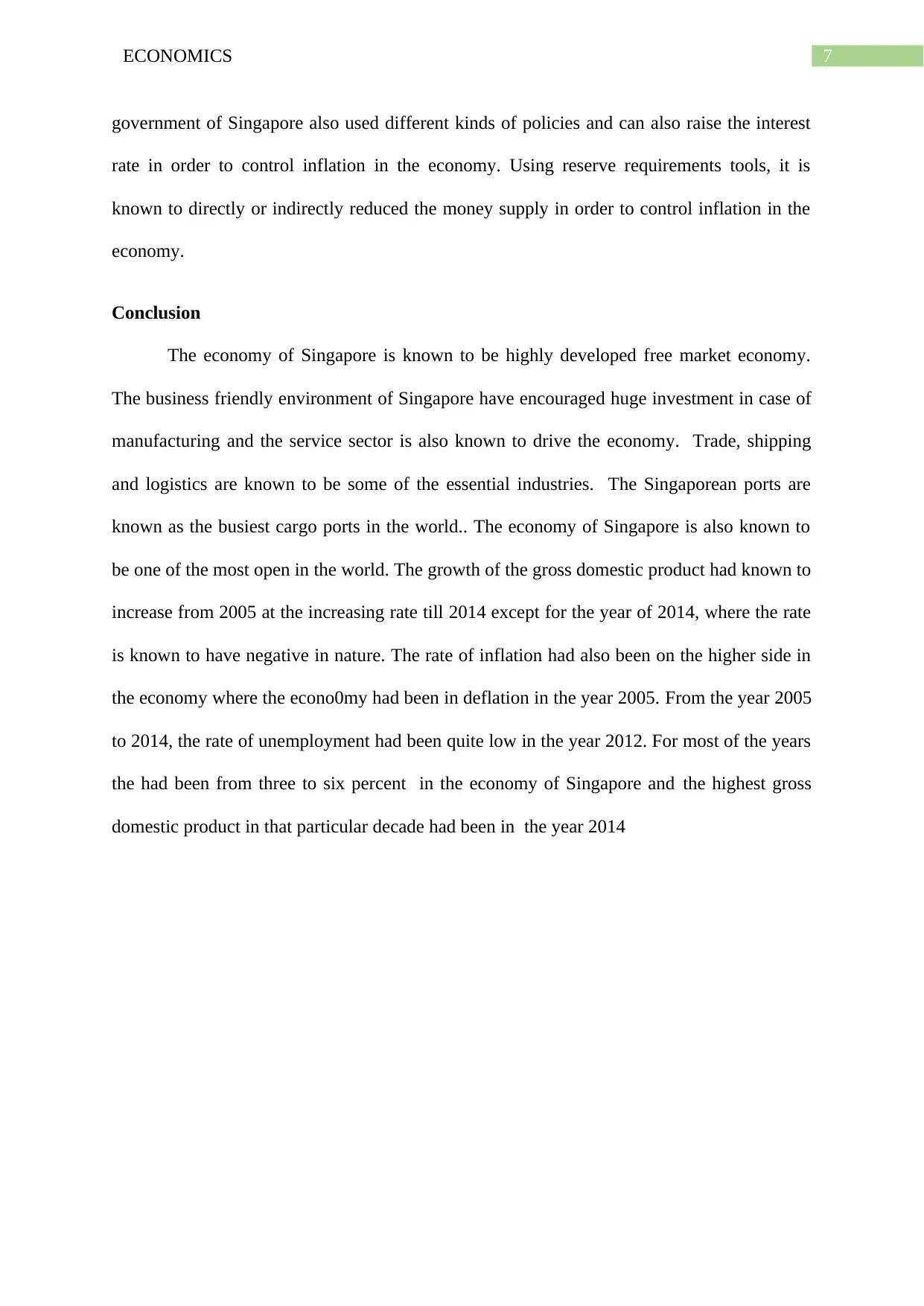
7ECONOMICS
government of Singapore also used different kinds of policies and can also raise the interest
rate in order to control inflation in the economy. Using reserve requirements tools, it is
known to directly or indirectly reduced the money supply in order to control inflation in the
economy.
Conclusion
The economy of Singapore is known to be highly developed free market economy.
The business friendly environment of Singapore have encouraged huge investment in case of
manufacturing and the service sector is also known to drive the economy. Trade, shipping
and logistics are known to be some of the essential industries. The Singaporean ports are
known as the busiest cargo ports in the world.. The economy of Singapore is also known to
be one of the most open in the world. The growth of the gross domestic product had known to
increase from 2005 at the increasing rate till 2014 except for the year of 2014, where the rate
is known to have negative in nature. The rate of inflation had also been on the higher side in
the economy where the econo0my had been in deflation in the year 2005. From the year 2005
to 2014, the rate of unemployment had been quite low in the year 2012. For most of the years
the had been from three to six percent in the economy of Singapore and the highest gross
domestic product in that particular decade had been in the year 2014
government of Singapore also used different kinds of policies and can also raise the interest
rate in order to control inflation in the economy. Using reserve requirements tools, it is
known to directly or indirectly reduced the money supply in order to control inflation in the
economy.
Conclusion
The economy of Singapore is known to be highly developed free market economy.
The business friendly environment of Singapore have encouraged huge investment in case of
manufacturing and the service sector is also known to drive the economy. Trade, shipping
and logistics are known to be some of the essential industries. The Singaporean ports are
known as the busiest cargo ports in the world.. The economy of Singapore is also known to
be one of the most open in the world. The growth of the gross domestic product had known to
increase from 2005 at the increasing rate till 2014 except for the year of 2014, where the rate
is known to have negative in nature. The rate of inflation had also been on the higher side in
the economy where the econo0my had been in deflation in the year 2005. From the year 2005
to 2014, the rate of unemployment had been quite low in the year 2012. For most of the years
the had been from three to six percent in the economy of Singapore and the highest gross
domestic product in that particular decade had been in the year 2014
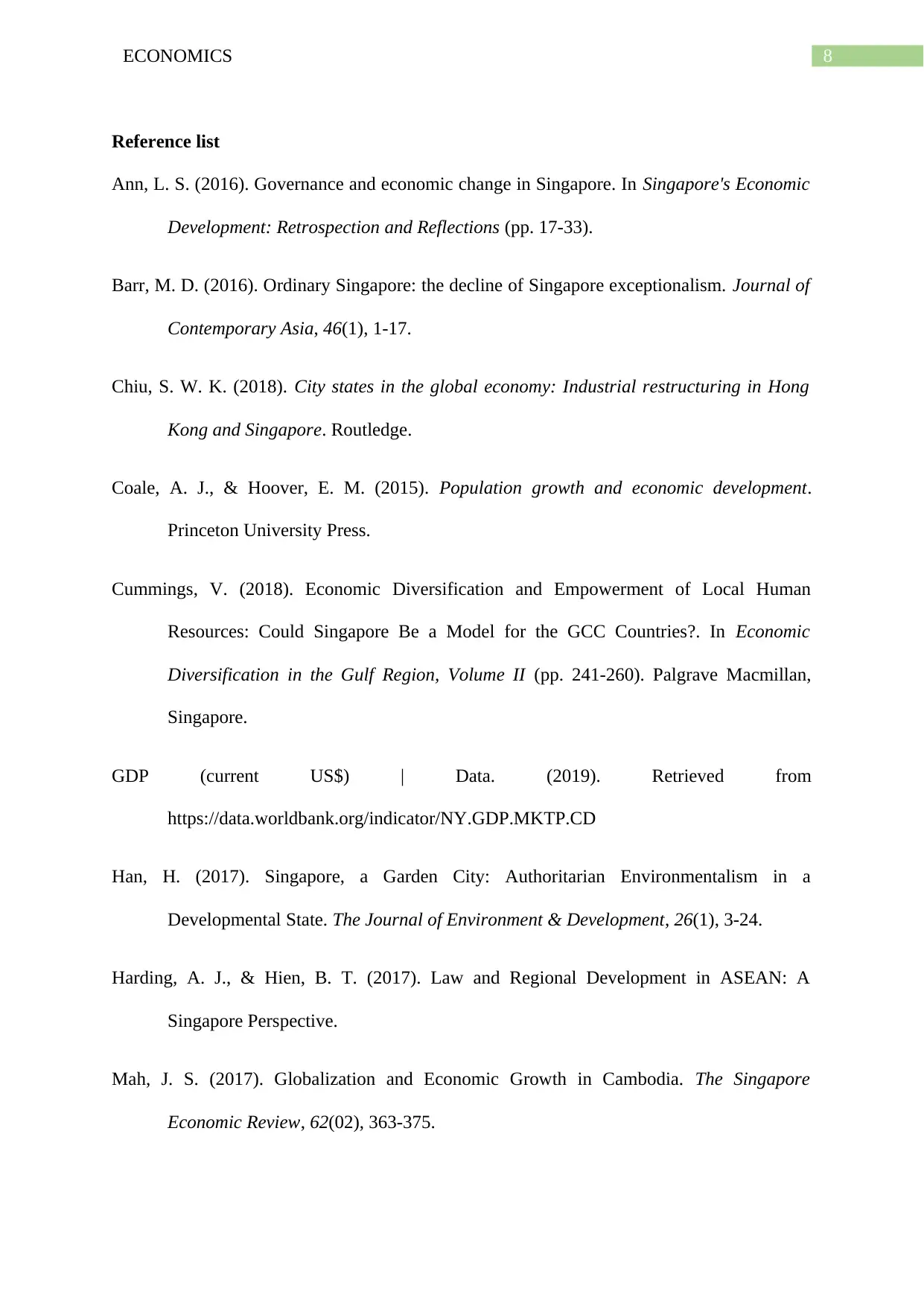
8ECONOMICS
Reference list
Ann, L. S. (2016). Governance and economic change in Singapore. In Singapore's Economic
Development: Retrospection and Reflections (pp. 17-33).
Barr, M. D. (2016). Ordinary Singapore: the decline of Singapore exceptionalism. Journal of
Contemporary Asia, 46(1), 1-17.
Chiu, S. W. K. (2018). City states in the global economy: Industrial restructuring in Hong
Kong and Singapore. Routledge.
Coale, A. J., & Hoover, E. M. (2015). Population growth and economic development.
Princeton University Press.
Cummings, V. (2018). Economic Diversification and Empowerment of Local Human
Resources: Could Singapore Be a Model for the GCC Countries?. In Economic
Diversification in the Gulf Region, Volume II (pp. 241-260). Palgrave Macmillan,
Singapore.
GDP (current US$) | Data. (2019). Retrieved from
https://data.worldbank.org/indicator/NY.GDP.MKTP.CD
Han, H. (2017). Singapore, a Garden City: Authoritarian Environmentalism in a
Developmental State. The Journal of Environment & Development, 26(1), 3-24.
Harding, A. J., & Hien, B. T. (2017). Law and Regional Development in ASEAN: A
Singapore Perspective.
Mah, J. S. (2017). Globalization and Economic Growth in Cambodia. The Singapore
Economic Review, 62(02), 363-375.
Reference list
Ann, L. S. (2016). Governance and economic change in Singapore. In Singapore's Economic
Development: Retrospection and Reflections (pp. 17-33).
Barr, M. D. (2016). Ordinary Singapore: the decline of Singapore exceptionalism. Journal of
Contemporary Asia, 46(1), 1-17.
Chiu, S. W. K. (2018). City states in the global economy: Industrial restructuring in Hong
Kong and Singapore. Routledge.
Coale, A. J., & Hoover, E. M. (2015). Population growth and economic development.
Princeton University Press.
Cummings, V. (2018). Economic Diversification and Empowerment of Local Human
Resources: Could Singapore Be a Model for the GCC Countries?. In Economic
Diversification in the Gulf Region, Volume II (pp. 241-260). Palgrave Macmillan,
Singapore.
GDP (current US$) | Data. (2019). Retrieved from
https://data.worldbank.org/indicator/NY.GDP.MKTP.CD
Han, H. (2017). Singapore, a Garden City: Authoritarian Environmentalism in a
Developmental State. The Journal of Environment & Development, 26(1), 3-24.
Harding, A. J., & Hien, B. T. (2017). Law and Regional Development in ASEAN: A
Singapore Perspective.
Mah, J. S. (2017). Globalization and Economic Growth in Cambodia. The Singapore
Economic Review, 62(02), 363-375.
⊘ This is a preview!⊘
Do you want full access?
Subscribe today to unlock all pages.

Trusted by 1+ million students worldwide
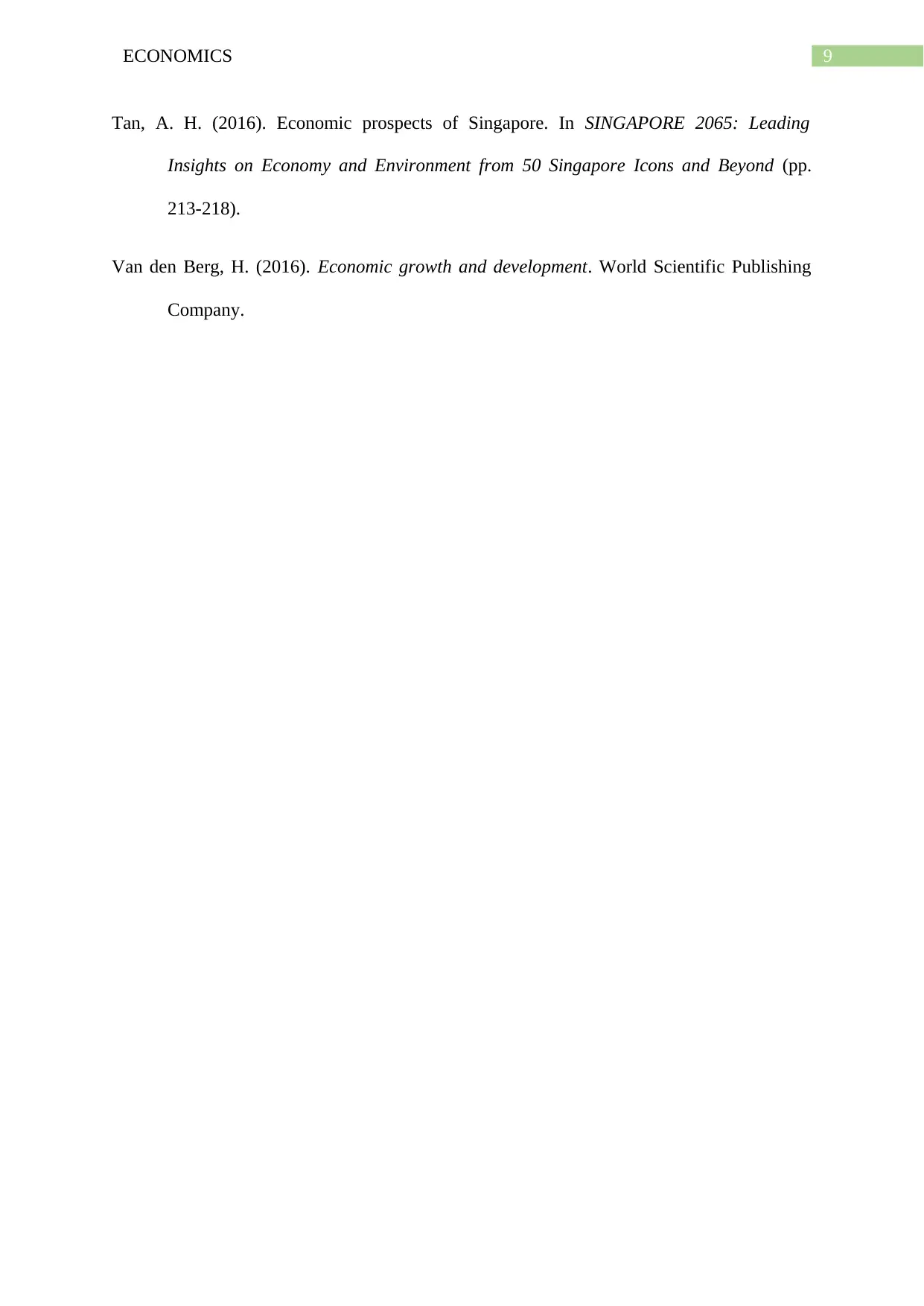
9ECONOMICS
Tan, A. H. (2016). Economic prospects of Singapore. In SINGAPORE 2065: Leading
Insights on Economy and Environment from 50 Singapore Icons and Beyond (pp.
213-218).
Van den Berg, H. (2016). Economic growth and development. World Scientific Publishing
Company.
Tan, A. H. (2016). Economic prospects of Singapore. In SINGAPORE 2065: Leading
Insights on Economy and Environment from 50 Singapore Icons and Beyond (pp.
213-218).
Van den Berg, H. (2016). Economic growth and development. World Scientific Publishing
Company.
1 out of 10
Related Documents
Your All-in-One AI-Powered Toolkit for Academic Success.
+13062052269
info@desklib.com
Available 24*7 on WhatsApp / Email
![[object Object]](/_next/static/media/star-bottom.7253800d.svg)
Unlock your academic potential
Copyright © 2020–2025 A2Z Services. All Rights Reserved. Developed and managed by ZUCOL.




